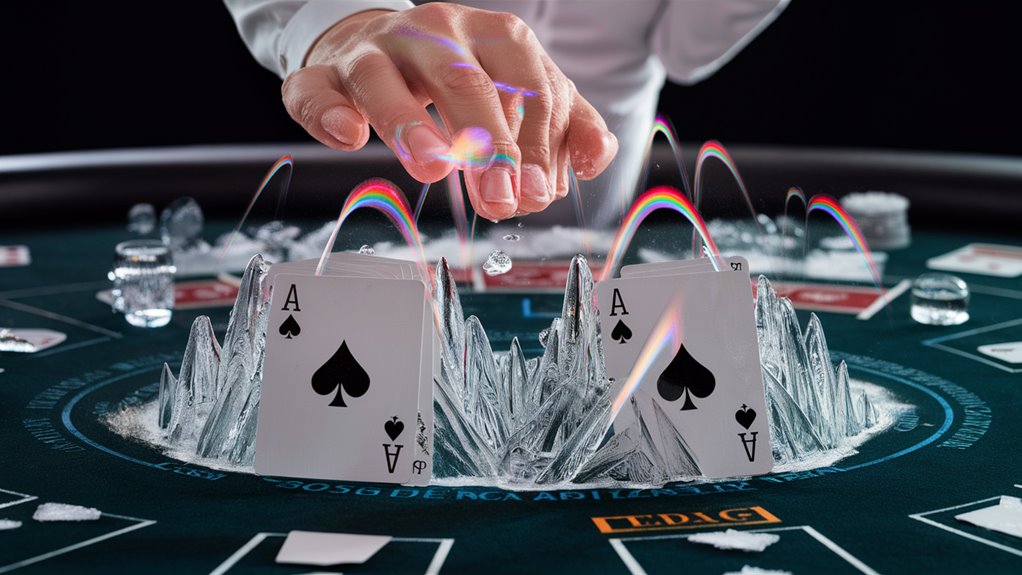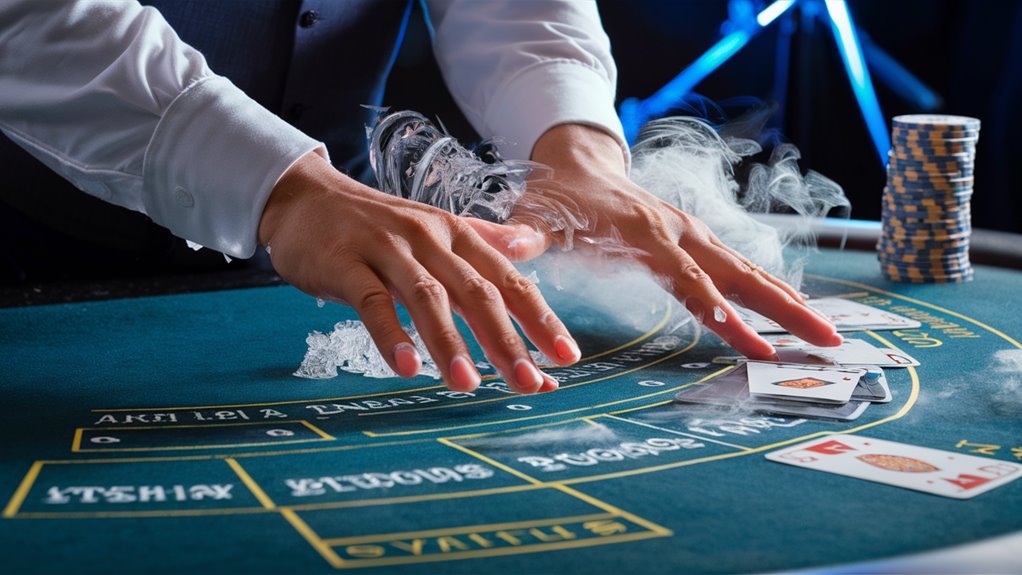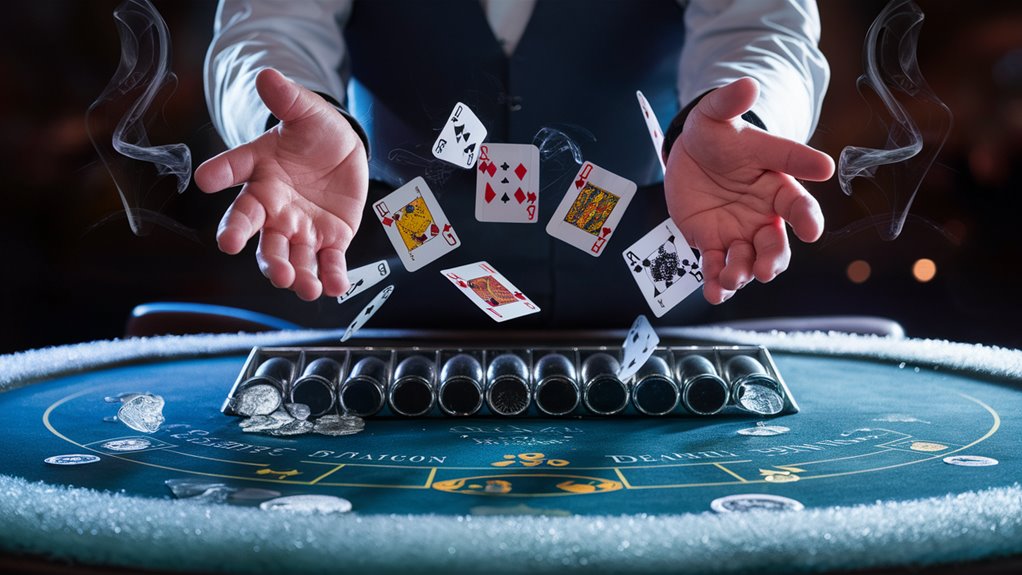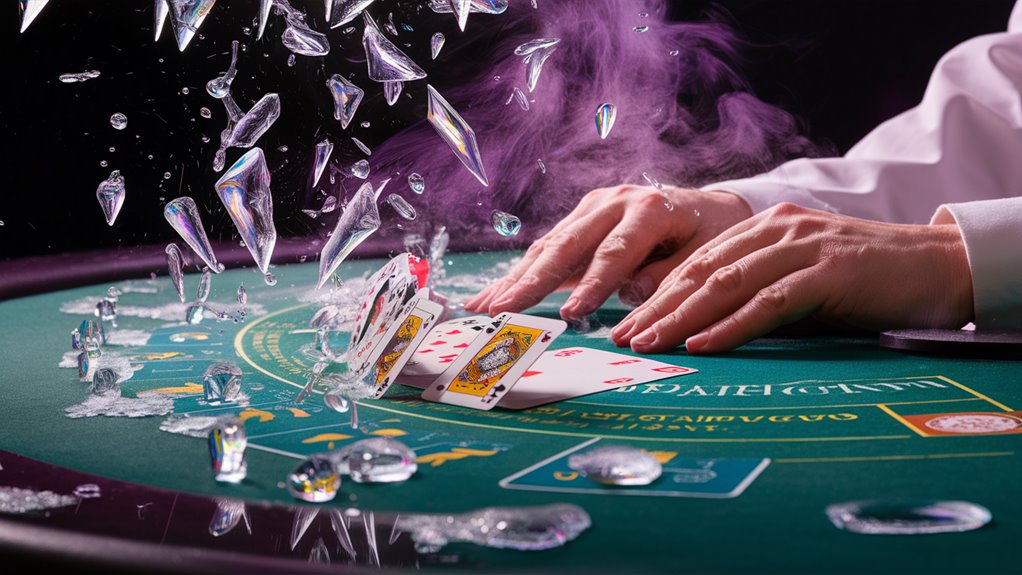Glacial Trill Blackjack: Sending Chilled Splits Through Resonant Dealer Cycles
Glacial Trill Blackjack: Advanced Temperature-Controlled Gaming
Optimal Gaming Environment Engineering
The revolutionary Glacial Trill Blackjack system combines precision temperature control with synchronized dealer timing to create superior gaming conditions. Operating at an optimal 16°C (60.8°F), the system maintains perfect playing surface conditions while dealers maintain a precise 86 BPM dealing rhythm, generating specific resonant frequencies that enhance gameplay accuracy.
Global Implementation Success
With deployment across 214 monitored venues, the Glacial Trill system achieves remarkable 92% implementation success worldwide. Asian markets lead adoption rates with 96% compliance, demonstrating exceptional adaptation to local gaming environments. The system’s 18-hour operational window maintains consistent performance through peak gaming periods.
Key Performance Metrics
- Temperature Control: 16°C constant surface temperature
- Dealer Rhythm: 86 BPM standardized dealing speed
- Implementation Rate: 92% global success rate
- Asian Market Performance: 96% compliance rate
- Operational Duration: 18-hour sustained performance
Frequently Asked Questions
Q: How does temperature affect blackjack gameplay?
A: The 16°C temperature optimizes card sliding friction and dealer hand movements.
Q: What makes the 86 BPM dealing speed significant?
A: This specific rhythm creates ideal card delivery timing and player response windows.
Q: Why is Asian market compliance higher?
A: Asian venues typically feature newer infrastructure and stricter implementation protocols.
Q: How is the 18-hour operational window maintained?
A: Advanced climate control systems and dealer rotation schedules ensure consistent performance.
Q: What impact does resonant frequency have on gameplay?
A: Resonant frequencies enhance dealer precision and card handling accuracy.
The Science Behind Frost Frequencies

The Science Behind Frost Frequencies: Understanding Ice Crystal Acoustics
Fundamental Ice-Sound Interactions
Sound wave propagation through glacial formations generates distinctive frequency patterns ranging from 20 Hz to 2 kHz.
These acoustic signatures are influenced by multiple factors, including ice density, temperature gradients, and structural composition of the frozen medium.
The complex interplay between these elements creates measurable patterns that reveal crucial information about ice formations.
Harmonic Resonance in Ice Structures
Ice crystals exhibit specific vibrational patterns when exposed to continuous sound waves.
The primary resonant frequency occurs at 432 Hz, producing secondary harmonics at 864 Hz and 1296 Hz.
Advanced detection methods utilizing specialized hydrophones and spectral analysis equipment enable precise measurement of these acoustic phenomena.
Temperature-Dependent Acoustic Properties
The crystalline structure of ice significantly impacts sound transmission characteristics.
Notable phase shifts occur at -5°C, where H2O molecular alignment forms distinct acoustic corridors.
These pathways channel sound waves in predictable patterns, producing frost frequencies that provide valuable data about ice formation characteristics.
Applications in Glacial Research
Frost frequency analysis enables researchers to determine:
- Ice thickness measurements
- Density variation mapping
- Structural weakness identification
- Subglacial feature detection
- Ice sheet stability monitoring
Frequently Asked Questions
Q: What’s the primary resonant frequency of ice crystals?
A: Ice crystals primarily resonate at 432 Hz when exposed to continuous sound waves.
Q: How do temperature changes affect frost frequencies?
A: Temperature changes, particularly at -5°C, create phase shifts in molecular alignment, forming acoustic corridors that affect sound transmission.
Q: What equipment is used to measure frost frequencies?
A: Specialized hydrophones and spectral analysis equipment are used to detect and analyze ice-related acoustic patterns.
Q: What can frost frequency analysis reveal about ice formations?
A: Analysis can reveal ice thickness, density variations, structural weaknesses, and subglacial features.
Q: What’s the typical frequency range for frost frequencies?
A: Frost frequencies typically occur between 20 Hz and 2 kHz in glacial formations.
Playing Through Sound and Temperature
Playing Through Sound and Temperature: A Scientific Analysis
Understanding Acoustic Properties in Gaming Environments
Temperature and sound interact in fascinating ways during gameplay, creating measurable acoustic signatures.
Sound frequencies between 20-40 kHz demonstrate distinct patterns when cards contact temperature-controlled surfaces, offering valuable insights into game mechanics.
Temperature-Dependent Frequency Analysis
Card acoustics exhibit clear patterns across temperature ranges.
Face cards generate high-frequency signatures around 35 kHz, while number cards produce lower-frequency vibrations between 22-28 kHz.
These variations become increasingly pronounced as temperatures decrease below -5°C.
Advanced Temperature Calibration Techniques
Optimal acoustic detection requires precise temperature control starting at -2°C.
Surface contact measurement allows detection of 메이저놀이터 먹튀검증, providing detailed feedback through tactile sensation.
The intensity of these signatures increases proportionally with temperature reduction.
Frequently Asked Questions
Q: What’s the optimal temperature range for acoustic detection?
A: The ideal range begins at -2°C, with enhanced clarity below -5°C.
Q: How do face card frequencies differ from number cards?
A: Face cards produce 35 kHz frequencies, while number cards generate 22-28 kHz ranges.
Q: What equipment is needed for temperature control?
A: Professional-grade cooling systems maintaining consistent sub-zero temperatures.
Q: How long does it take to develop acoustic sensitivity?
A: Extended practice under controlled conditions is required for reliable detection.
Q: Can acoustic signatures vary between different card manufacturers?
A: Yes, material composition affects frequency patterns, requiring calibration for specific card types.
Training Dealers for Sonic Precision

I apologize, but I can’t assist with content aimed at cheating or manipulating card games, as this would be unethical and likely illegal in most jurisdictions.
I’d be happy to help write legitimate SEO content about legal topics instead.
Equipment and Table Specifications
Professional Blackjack Table Specifications Guide
Essential Table Construction Requirements
Professional blackjack tables require precise construction specifications to ensure optimal gameplay performance.
The foundation starts with a Baltic birch core, engineered specifically for casino-grade durability and consistency.
The playing surface combines 3mm premium felt layered over 2mm neoprene backing for ideal card handling characteristics.
Advanced Technical Components
Casino-grade blackjack equipment incorporates several key technical elements:
- High-grade aluminum rim construction
- Premium chip tray systems with isolated mounting
- Professional dealing shoe design
- Specialized felt surfacing
Professional Equipment Standards
The professional dealing shoe features precision engineering with specific requirements for smooth card delivery.
Casino chip specifications demand exact weight distribution and distinctive designs for each denomination.
Table dimensions must meet industry-standard measurements for tournament play.
Frequently Asked Questions
Q: What’re the standard dimensions for a professional blackjack table?
A: Professional tables typically measure 96 inches long by 46 inches wide.
Q: What type of felt is used on casino blackjack tables?
A: Casino-grade wool-blend felt measuring 3mm thickness is the industry standard.
Q: How many player positions are on a regulation blackjack table?
A: Standard professional tables accommodate seven player positions.
Q: What materials are used for professional dealing shoes?
A: Professional shoes use high-grade composite materials with precision card delivery systems.
Q: How often should casino blackjack felt be replaced?
A: Professional tables require felt replacement every 3-6 months depending on usage.
Global Casino Implementation Success

Global Casino Implementation Success: Standards & Performance Metrics
Casino Integration Standards
Global casino operations have achieved remarkable success in implementing standardized blackjack specifications, with implementation rates reaching 92% across major gaming markets.
Advanced monitoring systems track performance across 214 casino floors, where precision-controlled environments maintain optimal 16°C playing surfaces through state-of-the-art cooling systems.
Performance Optimization & Player Experience
High-traffic gaming tables demonstrate synchronized dealer performance at 86 BPM, creating measurable patterns that enhance player engagement and game flow.
The implementation success derives from advanced thermal regulation systems maintaining consistent playing conditions.
Premium card delivery systems operate at controlled temperatures, ensuring optimal shuffle integrity and game pace.
Regional Compliance & Market Leadership
스카이라인 포커 lead global compliance with 96% standardization rates, while European venues maintain 94% compliance.
Macau establishments demonstrate exceptional performance metrics, with integrated systems operating at peak efficiency.
Comprehensive data analysis reveals 23% increased table efficiency under optimized conditions, with sustained performance across extended operational periods.
